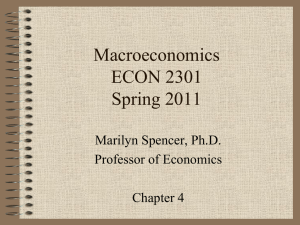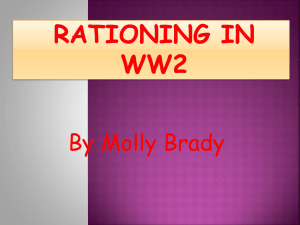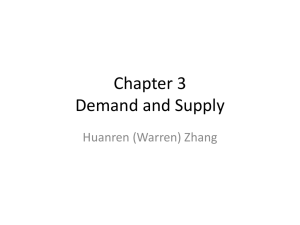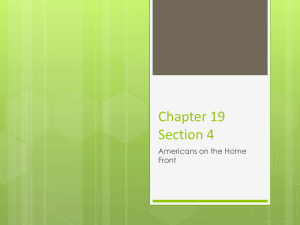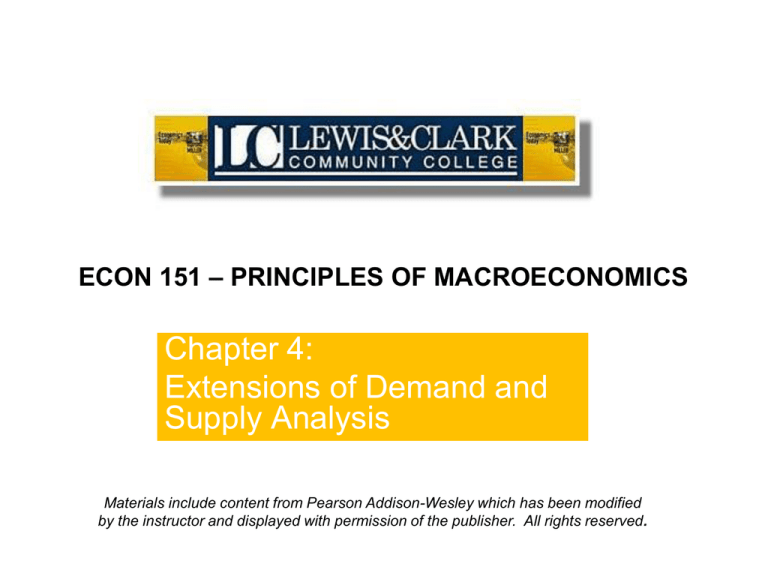
ECON 151 – PRINCIPLES OF MACROECONOMICS
Chapter 4:
Extensions of Demand and
Supply Analysis
Materials include content from Pearson Addison-Wesley which has been modified
by the instructor and displayed with permission of the publisher. All rights reserved.
The Price System
Price System (market system)
An
economic system that allocates resources
based on relative prices determined by supply
and demand
Prices signal what is relatively scarce
and relatively abundant
2
Exchange and Markets
Markets
Emphasize
voluntary exchange
Determine the terms of exchange
Facilitate exchange
3
Exchange and Markets
Voluntary Exchange
Acts
of trading between individuals
that make both parties to the trade
subjectively better off
Terms of Exchange
The
prices we pay for the desired items
4
Exchange and Markets
Transaction Cost
The
costs associated with exchange
Examples
Price shopping
Determining quality
Determining reliability
Service availability
Cost of contracting
5
Exchange and Markets
The role of middlemen
Middlemen
(intermediaries) or brokers reduce
transaction cost by providing information to
buyers and sellers.
Examples
Real estate brokers
Stock brokers
Consignment shops
Car dealerships
6
Changes in Demand and
Supply
Changes in supply and demand
create a disequilibrium
The market price and quantity
adjust to a new equilibrium
7
Shifts in Demand and Supply:
Determine Results
Increase Demand with Supply Constant
S
E1
P1
D1
Q1
Figure 4-1
8
Shifts in Demand and Supply:
Determine Results
Increase Demand with Supply Constant
S
At price P1 quantity
demanded exceeds
quantity supplied—
a shortage exists
E1
P1
D1
Q1
Figure 4-1
D2
Q2
9
Shifts in Demand and Supply:
Determine Results
Increase Demand with Supply Constant
S
E2
Equilibrium price
and quantity
increase to P2 and Q2
P2
E1
P1
D1
Q1
Figure 4-1
Q2
D2
10
Shifts in Demand and Supply:
Determinate Results
Decrease Demand with Supply Constant
E1
S
At price P1 quantity
supplied exceeds
quantity demanded—
a surplus exists.
P1
D1
D2
Q2
Figure 4-1
Q1
11
Shifts in Demand and Supply:
Determinate Results
Decrease Demand with Supply Constant
E1
S
Equilibrium price
and quantity decrease
to P3 and Q3
P1
E3
P3
D1
D3
Q3
Figure 4-1
Q1
12
Shifts in Demand and Supply:
Determinate Results
Increase Supply with Demand Constant
S1
E1
P1
D
Q1
Figure 4-1
13
Shifts in Demand and Supply:
Determinate Results
Increase Supply with Demand Constant
At price P1 quantity
supplied exceeds
quantity demanded—
a surplus exists
S1
S2
E1
P1
D
Q1
Figure 4-1
Q3
14
Shifts in Demand and Supply:
Determinate Results
Increase Supply with Demand Constant
Equilibrium price
decreases and quantity
increases to P2 and Q2
S1
S2
E1
P1
E2
P2
D
Q1
Figure 4-1
Q2
15
Shifts in Demand and Supply:
Determinate Results
Decrease Supply with Demand Constant
S3
S1
E1
At price P1 quantity
demanded exceeds
quantity supplied—
a shortage exists
P1
D
Q2
Figure 4-1
Q1
16
Shifts in Demand and Supply:
Determinate Results
Decrease Supply with Demand Constant
S3
E3
S1
P3
Equilibrium price
decreases and quantity
increases to P3 and Q3
E1
P1
D
Q3
Figure 4-1
Q1
17
Changes in Demand and
Supply
Summary
Increases
in demand increase equilibrium
price and quantity.
Decreases in demand decrease equilibrium
price and quantity.
18
Changes in Demand and
Supply
Summary
Increases
in supply decrease equilibrium
price and increase equilibrium quantity.
Decreases in supply increase equilibrium
price and decrease equilibrium quantity.
19
Changes in Demand and
Supply
When both demand and supply shift
Simultaneous
changes in demand
and supply put conflicting pressure
on price or quantity
The resulting effect depends upon how much
each curve shifts
Either equilibrium price or quantity
will be indeterminate
20
Changes in Demand and
Supply
When both demand and supply increase
Change
in price is indeterminate
Quantity will increase
When both demand and supply decrease
Change
in price is indeterminate
Quantity will decrease
21
Changes in Demand and
Supply
When supply decreases and demand increases
Price
will increase
Change in quantity is indeterminate
When supply increases and demand decreases
Price
will decrease
Change in quantity is indeterminate
22
Change in demand or supply
Demand
Supply
Price
Quantity
Increase
Increase
Increase
Decrease
Decrease
Decrease
Increase
Decrease
Increase
Decrease
Increase
Decrease
Change in both demand and supply
Demand
Supply
Price
Quantity
Increase
Increase
Unknown
Increase
Increase
Decrease
Increase
Unknown
Decrease
Increase
Decrease
Unknown
Decrease
Decrease
Unknown
Decrease
23
Price Flexibility
and Adjustment Speed
Adjustment speed
Market
characteristics influence adjustment
speed
Markets may overshoot in the adjustment
process
24
The Rationing Function of Prices
When surpluses and shortages exist, the
price adjusts to clear the market.
This adjustment is the rationing function of
price.
25
The Rationing Function of Prices
When prices cannot adjust non-price
rationing occurs
Rationing
by queues
Rationing by lotteries
Rationing by coupons
26
The Rationing Function of Prices
The essential role of rationing
With
scarcity rationing must occur
We must choose the rationing mechanism:
price or non-price
Price rationing is the most efficient
Further trades could not occur without making
somebody worse-off
27
The Policy of Government-Imposed
Price Controls
Price Controls
Government-mandated
minimum
or maximum prices
Price Ceiling
A
legal maximum price
Price Floor
A
legal minimum price
28
The Policy of Government-Imposed
Price Controls
Non-Price Rationing Devices
All
methods used to ration scarce goods that
are price-controlled
Black Market
A
market in which price-controlled goods are
sold at an illegally high price
29
Black Markets
S’
Implicit supply schedule
at P1 < Pe
Price
P2
Pe
P1
Shortage
D
Qs
Figure 4-3
Qe
Qd
Quantity per Unit Time Period
30
The Policy of Controlling Rents
The functions of rental prices
Promote
the efficient maintenance
and construction of housing
Allocate existing housing
Ration the use of housing
31
The Policy of Controlling Rents
Effects on the existing supply
of housing
Property
owners cannot recover costs
Rationing the current use of housing
Reduces
mobility
New York’s “housing gridlock”
32
The Policy of Controlling Rents
Who gains and who loses
from rent controls?
Losers
Property owners
Low-income individuals
Benefits
Upper-income professionals
33
Price Floors in Agriculture
Support Price
the
governmentally established minimum
price farmers are to receive for a particular
agricultural product.
34
Agricultural Price Supports
Excess quantity
supplied
S
Dollars per Unit
Ps
Pe
E
D
Qd Qe
Figure 4-4
Qs
Quantity of Peanuts per Time Period
35
Price Floors in the Labor Market
Minimum Wage
Lowest
hourly wage rate that firms
may legally pay their workers
36
The Effect of Minimum Wages
S
A
Wage Rate per Unit
Wm
B
We
C
Excess quantity
supplied at
wage Wm
E
Reduction
in quantity
of labor
demanded
Increase in
quantity of labor
supplied
D
Qd
Qe
Qs
Quantity of Labor per Time Period
Figure 4-5
37
Quantity Restrictions
Prohibitions on the ownership
or trading of a good
Human
organs
Drugs
Hospital
beds
38
Quantity Restrictions
Government Prohibitions or Licensing
Requirements
Some
commodities cannot be purchased at all legally;
others require a license.
Import Quota
Supply
restriction that prohibits
the importation of more than a specified quantity of a
particular good in a one-year period
39
ECON 151 – PRINCIPLES OF MACROECONOMICS
Chapter 4:
Extensions of Demand and
Supply Analysis
Materials include content from Pearson Addison-Wesley which has been modified
by the instructor and displayed with permission of the publisher. All rights reserved.





